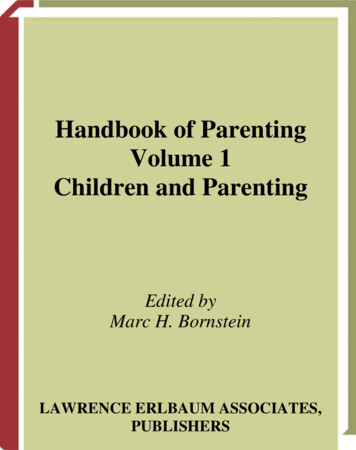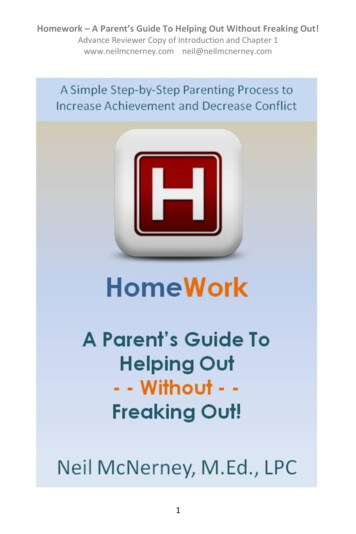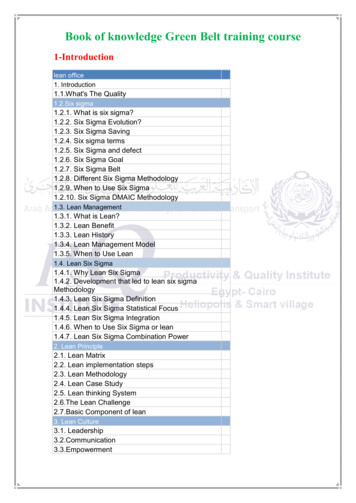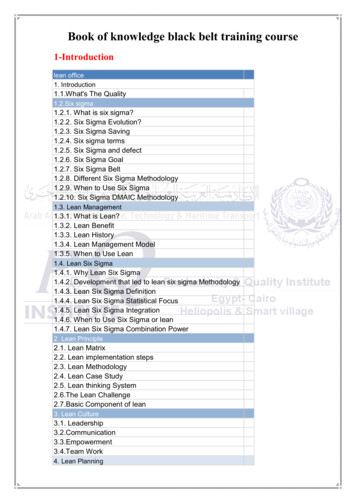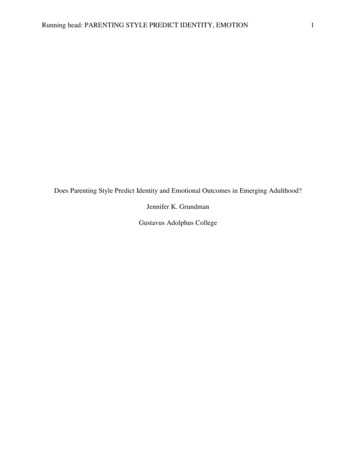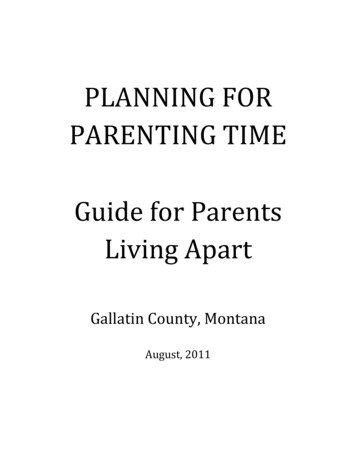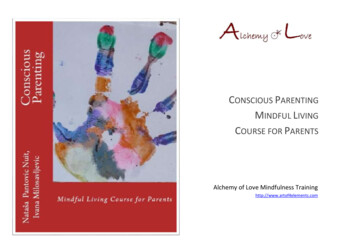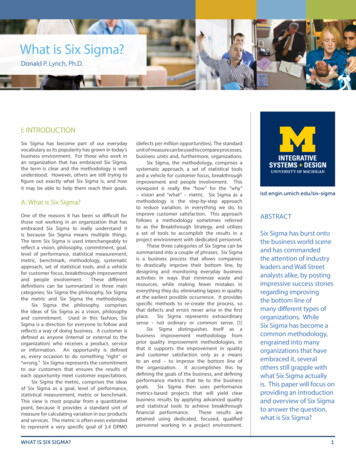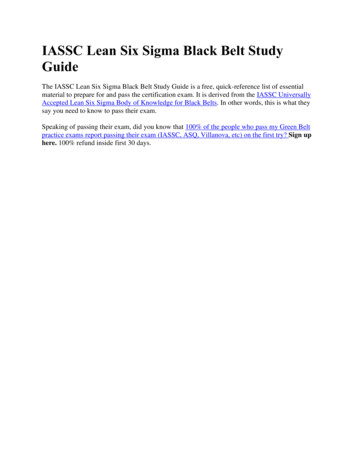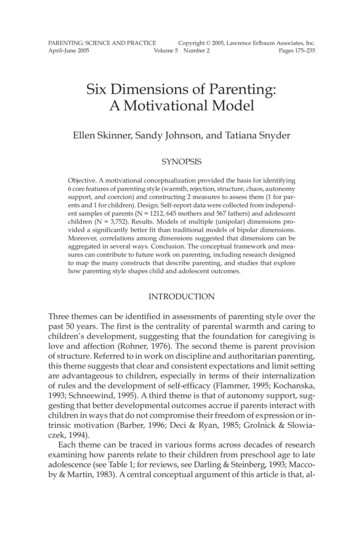
Transcription
PARENTING: SCIENCE AND PRACTICECopyright 2005, Lawrence Erlbaum Associates, Inc.April–June 2005Volume 5 Number 2Pages 175–235Six Dimensions of Parenting:A Motivational ModelEllen Skinner, Sandy Johnson, and Tatiana SnyderSYNOPSISObjective. A motivational conceptualization provided the basis for identifying6 core features of parenting style (warmth, rejection, structure, chaos, autonomysupport, and coercion) and constructing 2 measures to assess them (1 for parents and 1 for children). Design. Self-report data were collected from independent samples of parents (N 1212, 645 mothers and 567 fathers) and adolescentchildren (N 3,752). Results. Models of multiple (unipolar) dimensions provided a significantly better fit than traditional models of bipolar dimensions.Moreover, correlations among dimensions suggested that dimensions can beaggregated in several ways. Conclusion. The conceptual framework and measures can contribute to future work on parenting, including research designedto map the many constructs that describe parenting, and studies that explorehow parenting style shapes child and adolescent outcomes.INTRODUCTIONThree themes can be identified in assessments of parenting style over thepast 50 years. The first is the centrality of parental warmth and caring tochildren’s development, suggesting that the foundation for caregiving islove and affection (Rohner, 1976). The second theme is parent provisionof structure. Referred to in work on discipline and authoritarian parenting,this theme suggests that clear and consistent expectations and limit settingare advantageous to children, especially in terms of their internalizationof rules and the development of self-efficacy (Flammer, 1995; Kochanska,1993; Schneewind, 1995). A third theme is that of autonomy support, suggesting that better developmental outcomes accrue if parents interact withchildren in ways that do not compromise their freedom of expression or intrinsic motivation (Barber, 1996; Deci & Ryan, 1985; Grolnick & Slowiaczek, 1994).Each theme can be traced in various forms across decades of researchexamining how parents relate to their children from preschool age to lateadolescence (see Table 1; for reviews, see Darling & Steinberg, 1993; Maccoby & Martin, 1983). A central conceptual argument of this article is that, al-
176TABLE 1Comprehensive Historical Overview of the Dimensions Included in Parenting Measures Over the Last 60 Years(In Chronological Order)MeasureDimensionsFels Parent BehaviorScalesChampney, 1941, ascited in Baldwin,Kalhorn, and Breese,1945Democracy in the homeFels Parent BehaviorScalesRoff, 1949Freedom–arbitrary onal–nonrationalTraining–free growthAcceptance of childIndulgenceDefinitionsJustification, democracy, and clarity of policy, explanations, approval,understanding versus restrictive, coerciveAcceptance, rapport, affection, approval, effectiveness, child-centeredness versusdisciplinary frictionProtectiveness, babying, child-centered, acceptance, solicitous, duration andintensity of contactSocialized–individualizedChild free to act versus restrained by autocratic controlChild constantly subjected to attention, affection versus neglected, ignoredEverything done for child versus encouraged to do things for himselfHome is erratic, discordant, tense versus harmonious, relaxed, pleasantChild typically praised versus blamed, disapprovedAttitude toward child is logical, intellectual versus expedient, emotionalPushes child for rapid development by training versus makes no effort toaccelerate developmentHome is friendly, sociable versus reclusive, isolatedParent Attitude SurveyShoben, 1949IgnoringPossessiveDominatingA child should be seen and not heard.Children should be allowed to do as they please.Children need some of the natural meanness taken out of them.Fels Parent BehaviorScalesLorr and Jenkins, 1953Dependence-encouragingBabying, child-centeredness of home, solicitousness, protectiveness, intensityand duration of contact, acceptanceDemocracy and clarity of policy, explanations, understanding child’s problems;low coerciveness of suggestion, restrictiveness, emotionality, criticism,disciplinary frictionStrict orderliness, enforcement, severity of penalties, pushing, coordination ofhousehold; chaotic disorderDemocracy of childtrainingOrganization andeffectiveness of control
Fels Parent BehaviorScalesBaldwin, essChild-centered, approval, acceptance, affection, rapportBabying, protectiveness, solicitousnessJustification and democracy of policyAcceleration, explanations, understandingRestrictive regulations, coercive suggestionsReadiness of reinforcement, severity of punishmentReadiness of suggestions, quality of criticismAdjustment, effective policies versus disciplinary friction, discordActiveness, coordination, sociability of home, clarity of policy, duration ofcontact, emotionalityInterview and RatingScalesMilton, 1957, as cited inSears, Maccoby, andLevin, 1957Permissiveness-strictnessRestrictive, demanding, strict obedience, physical punishment versuspermissiveness for aggression and sexual behavior (e.g., nudity)Affection, time spent, responsiveness, praise, reasoningRestrictive, demanding, high standards, praise, tangible rewardsThree Data SetsSchaefer, 1959Warmth of relationshipResponsible child-trainingorientationAggressiveness andpunitivenessAutonomy versus controlLove versus hostility(Acceptance vs. rejection)Parental Role PatternsQuestionnaireSlater, 1962177Emotional supportivenessand warmth (Warmthvs. coldness)Inhibitory demands anddiscipline (Strictness vs.permissiveness)(Tolerance vs. intolerance)(Involvement vs.detachment)High demand and allow aggression to peers, physical punishment, low demandand allow aggression to parentsAutonomy versus maternal anxiety, intrusiveness concern about health,achievement demand, excessive contact, fostering dependency, emotionalinvolvementPositive evaluation, equalitarianism, affection versus ignoring, punitive, child isburden, strict, use of fear, punishment, irritabilityParent seen as helpful, rewarding, nurturant, affectionate, affiliative versus coldand emotionally deprivingParents seen as strict, authoritarian, puritanical, demanding, aggressive, punitiveversus permissive and indulgent(continued)
178TABLE 1 (Continued)MeasureDimensionsDefinitionsBecker, Peterson, Luria,Shoemaker, andHellmer, 1962Warmth versus hostilityPermissiveness versusrestrictivenessObjective (nonemotional), praise, reasoning versus nonacceptance, critical,hostile, disapproving, arbitraryLax, permits aggression to parents, noncoercive versus pressure for conformity,high standards, strict, demanding, rewardsA Parent-Child RelationsQuestionnaireRoe and Siegelman, sualWarm, attentive, praise, encourage independence, reasonsIndulgent, affectionate, intrusiveStrict obedience, punitive, restrictiveCold, hostile, derogatingNo attention or affection, coldMildly attentive and affectionate, easygoing, self-absorbedRosen, 1964Parental acceptance andsupportMy father is too busy to pay much attention to me. (-)When I have something to say, my mother listens.Children’s Report ofParental BehaviorInventory (CRPBI)Schaefer, 1965Table 1, p. 415Schluderman andSchluderman, 1970replicated factorsAutonomyAutonomy and loveExtreme autonomy, lax disciplineModerate autonomy, encourage sociability, encourage independent thinking,equalitarian treatmentPositive evaluation, sharing, affection, emotional supportIntellectual stimulation, child-centeredness, possessiveness, protectivenessIntrusiveness, suppression of aggression, control through guilt, parentaldirectionStrictness, punishment, naggingIrritability, negative evaluation, rejectionNeglect, ignoringCRPBI Schaefer, 1965, ascited in Schludermanand Schluderman, 1970Acceptance versusrejectionFirm control versus laxcontrolAutonomy versuspsychological controlLoveLove and controlControlControl and hostilityHostilityHostility and autonomy
The Parent Behavior FormWorell and Worell, 1974Encourages me to fool around with new ideasLikes me to assert my own ideas with herDoesn’t show that she loves meDoesn’t bother to enforce er, differenceRejection (undifferentiated)Says nice things about meNags or scolds me when I am badTotally ignores meDoes not really like meMother-Father-Peer ScaleEpstein, 1983Acceptance versusrejectionParental love, acceptance, and appreciation (“My mother loves being with me.”)Self-report Measure ofFamily FunctioningBloom, 1985Autonomy c, expressiveAuthoritarian, enmeshmentLaissez-faire, external locus of controlBarnes, Farrell, and Cairns,1986Control (coercive)Control (undifferentiated)Slaps or hits, yells or screams, takes away privilegesTells you how he/she expects you to act in the futureCompletely ignores you for a whileParental praise, reliance for guidance, physical affection, joint activities,decision-making, future plans, discuss personal problems, knowledge ofparental expectationsParental supportDornbusch, Ritter,Liederman, Roberts, andFraleigh, 1987Authoritarian index (8items)Permissive index (8 items)Authoritative index (9items)Tell not to argue, will know better when grown up, parents are correct and not tobe questioned; bad grades: get upset, reduce allowance, ground; good grades:do even better, other grades be as goodHard work at school not important (four subjects), don’t care bad grades, don’tcare good grades, no rules TV, not involved in education: does not attendprograms, help homework, or check homeworkParents look at both sides, admit youth sometimes knows more, talk politics,everyone helps decisions, poor grades: take freedom, try harder, offer help179(continued)
180TABLE 1 (Continued)MeasureDimensionsDefinitionsSocial ProvisionsScale-Parent VersionCutrona and Russell,1987GuidanceReliable allianceAttachmentSocial integrationReassurance of worthOpportunity to providenurturanceAdvice and informationTangible assistanceCaringSimilarity of interests and concernsPositive evaluation of skills and abilitiesProviding support to othersGrolnick and Wellborn,1988Grolnick and Ryan, 1989Parenting ContextQuestionnaireAutonomy supportInvolvementStructureValues autonomy, autonomy-oriented techniques, nondirectivenessParental knowledge, time spent, enjoymentRules and information, consistencySteinberg, Elmen, andMounts, 1989CRPBI- ThreedimensionsAcceptancePsychological autonomyBehavioral controlReverse-coded child has complete freedom to decide in 17 family areasChildren’s Perceptions ofParents ScaleGrolnick, Ryan, andDeci, 1991Forced choice measureAutonomy supportParental AuthorityQuestionnaireBuri, 1991Permissive (10 items)InvolvementAuthoritarian (10 items)Authoritative (10 items)Some mothers are always telling their children what to do, but other motherslike their children to decide for themselves what to do.Some fathers don’t have enough time to talk to their children about theirproblems, but other fathers always have time to talk to their children abouttheir problems.“My mother/father has always felt that what children need is to be free to makeup their own minds and to do what they want to do, even if this does notagree with what their parents might want.”“As I was growing up, my mother/father did not allow me to question anydecision he/she had made“My mother/father has always encouraged verbal give and take whenever Ihave felt that family rules and restrictions were unreasonable.”
Parenting style indexLamborn, Mounts,Steinberg, andDornbusch, 1991Acceptance/ involvementSteinberg, Lamborn,Dornbusch, and Darling,1992Acceptance/ involvementStrictness/supervisionAutonomy grantingSupportive Parenting ScaleSimons, Whitbeck,Conger, and Melby, 1992Parent reportHow often do you talk with your seventh grader about what is going on inhis/her life?Hardy, Power, and Jaedike,1993ControlStructureSupportAutonomy grantingAmount of control, restrictive attitude, control, protectivenessOrganization, consistencyCohesiveness, adaptability, nurturanceOver-involvement (-), autonomy grantingParenting PracticesBrown et al., 1993MonitoringHow much their parents really know about who their friends are, where theywere at night, etc.Turner, Irwin, Tschann,and Millstein, 1993Acceptance versus rejection(from Epstein, 1983)Autonomy supportParental love, acceptance, and appreciation (“My mother loves being with me.”)LaxnessIf my child gets upset, I back down and give in.I stick to what I said. (-)Things build up and I do things I don’t mean to.Things don’t get out of hand. (-)I make my child tell me why he/she did it.I say “no” or take some other action. (-)The Parenting ScaleArnold, O’Leary, Wolfe,and Acker, xtent to which adolescent perceives parents as loving, responsive, and involved(“I can count on her to help me out if I have some sort of problem.”)Parental monitoring and limit setting (“How much do your parents try to knowabout where you go at night?”)Extent to which parents employed noncoercive, democratic discipline andencouraged the child to express individuality within the family (“How oftendo your parents tell you that their ideas are correct and that you should notquestion them?” (-))Independence support versus overprotection181(continued)
182TABLE 1 (Continued)MeasureDimensionsDefinitionsColorado Self-Report ofFamily FunctioningInventory (CSRFFI)Barber, Olsen, & Shagel,1994Psychological controlInventory of ParentalInfluences (IPI)Campbell, 1994Parental supportParental pressureMy mother is pleased if I do my best.I’m afraid to go home with a failing grade.Parent InvolvementGrolnick andSlowiaczek, 1994Dedication of resources tothe child in a particulardomain.Behavioral involvement (Parent–School Interaction Questionnaires)Cognitive–intellectual involvementPersonal involvementPaulson, 1994DemandingnessResponsivenessParental InvolvementI would describe my mother as a strict parent.My mother expects me to tell her when I think a rule is unfair.My mother usually goes to parent–teacher conferences.Confusion, Hubbub, andOrder ScaleMatheny, Wachs,Ludwig, and Phillips,1995Environmental confusionParent behaviorsIt’s a real zoo in our home.The atmosphere in our home is calm. (-)You can’t hear yourself think in our home.We almost always seem to be rushed.Parent–Child IntimacyScale (1982)Delaney, 1996ClosenessHow much does your mom/dad accept you no matter what you do?Perceptions of ParentalReciprocity ScaleMcMaster and Wintre,1996Parental reciprocityParents don’t share their opinions with you, they tell you what to do.Behavioral controlFamily members find it hard to get away from each other.Parents make all the important decisions in our family.There is strict punishment for breaking the rules in our family.There are very few rules in our family.Members of our family can get away with almost anything.
Psychological ControlScale–Youth Self-Report(PCS-YSR)Barber, 1996Psychological controlOften interrupts meBrings up my past mistakes when he/she criticizes meOften changes his/her moods when with meTells me that I am not a good or loyal member of the familyBarber and Olsen, 1997ConnectionMakes me feel better after talking over my worries with him/her (from CRPBI)Herman, Dornbusch,Herron, Herting, 1997RegulationConnectionMonitoring, household organization, locus of decision-makingLoving, responsive, involved (My parents often spend time just talking with me.)(from Steinberg et al., 1991)Parents employed noncoercive democratic discipline and encouraged the adolescentto express individuality within the family (How often do your parents tell youthat their ideas are correct and that you should not question them?)Psychological autonomyOtto and Atkinson, 1997RegulationAfter-school supervisionParental regulationMonitoring school workTime watching TVChild PuppetInterview–Parent ScaleSessa, Avenevoli,Steinberg, and Morris,2001Bipolar by forced choiceHostility/psychologicalcontrolAnger and negative affect (My mom [does not] make[s] me cry.)Coercive actions that inhibit the development of emotional independenceExpression of love and enjoyment (My mom [does not] laugh[s] at my jokes.)Sensitivity to child and flexible parentingRules, routines, organization (At dinnertime my mom [does not] make[s] me sitat the table.)Expectations for age-appropriate behaviorPomerantz and Eaton,2001Intrusive supportChecked over homework when children did not request it.Helped with homework when children did not request it.Preschool ParentingMeasure (PPM)Sessa, Avenevoli,Steinberg, and Morris,2001Positive affectHostility (unipolar)Structure (bipolar)(When my child and I play together, we laugh a lot.)Anger and negative affect (I snap at my child when he/she gets on my nerves.)Rules, routines, organization (There is a set schedule in my house for which dayof the week we do shopping, etc.)Expression of love and enjoyment (I make my child feel that what she does isimportant.)Warmth andresponsivenessStructure/ demandingnessResponsiveness (unipolar)183Note. Labels of dimensions that appear in bold correspond to one of the six core dimensions included in this study, namely, warmth, rejection,structure, chaos, autonomy support, or coercion. Example items are in parenthesis. (-) items were reverse coded to tap the corresponding construct.
184SKINNER, JOHNSON, SNYDERthough the number of specific parent practices may be virtually unlimited,consensus is emerging in the field that these themes reflect a relativelysmall subset of dimensions that are critical to the quality of the emotionalclimate of parent – child interactions.Parenting dimensions, defined as the features, the qualities, the descriptive scheme used to capture the nature of parenting, represent one set ofbuilding blocks on which the study of parenting is built. If they are identified, researchers in the area can work toward consensus on operationaldefinitions, ensure that assessments are comprehensive, and use them incombination to create parenting typologies or types (e.g., authoritativeor indulgent). The accomplishment of these tasks will, in turn, promotecomparability across studies and facilitate the accumulation of knowledgeabout parenting. Hence, a key task for researchers has been to identifycore dimensions of parenting and to elaborate and clarify their definingfeatures.This study focused on six core features of parenting style and used a motivational model to integrate and organize them. These six features werethe basis for two assessments of parenting style, parent and child report,for use with children from preschool age to late adolescence. We conductedtwo studies to examine the structure of these measures. The key empiricalquestion was whether parenting can best be represented by a series of bipolar dimensions (e.g., warmth vs. rejection) or by multiple (unipolar) dimensions (e.g., warmth and rejection). It is typically assumed in currentconceptualizations and measures of parenting that dimensions are bipolar;such models are simpler and more parsimonious. However, if constructsare actually multidimensional, then some of the richness and complexityof parenting or parenting types may not be captured by traditional conceptualizations and assessments.Core Dimensions of ParentingOver the past several decades, parenting researchers have repeatedlysuggested that three dimensions can be considered as a set of core featuresof parenting style. These are warmth versus rejection, structure versuschaos, and autonomy support versus coercion. As can be seen in the historical overview in Table 1, these dimensions have appeared in assessments ofparenting for children from preschool age to late adolescence and havebeen tapped using a variety of methods, most notably parent- and child-report questionnaires, but also including open-ended interviews, ratingscales, and observations in vivo and in the laboratory.Indeed, these very three features of parenting, referred to as Acceptanceversus Rejection, Firm Control versus Lax Control, and Autonomy versus
SIX DIMENSIONS OF PARENTING185Psychological Control, were suggested as organizing dimensions for theChildren’s Report of Parental Behavior Inventory by Schaefer four decadesago (Schaefer, 1965; Schluderman & Schluderman, 1970). This measure canbe considered the “parent” or “grandparent” of many parenting assessments used today, in that current measures often rely on subscales or itemsfrom this inventory.Parenting dimensions similar to these three have also been identified inrecent work (e.g., Frank, Avery, & Lamam, 1988). A special issue of theJournal of Adolescent Research is organized around “three central dimensions of socialization important to healthy child development: connectionwith significant others, regulation of behavior, and the facilitation of psychological autonomy” (Barber, 1997, p. 5). One way in which connectionhas been discussed is “in terms of supportive, warm, nurturing or lovingrelationships between children and their parents” (Barber, 1997, p. 6). Adequate regulation of adolescents can be “measured in terms of supervision,monitoring, rule-setting, and other forms of behavioral control” (Barber,1997, p. 6). And autonomy refers to “the extent to which socialization practices facilitate and do not intrude on the child’s development of an independent sense of identity, efficacy, and worth” (Barber, 1997, p. 7).Figure 1 summarizes the definitions of the six core parenting constructsused in this study and lists analogous constructs from other conceptualizations. (Definitions of these closely related constructs can be found in Table1.) Each of these dimensions is described more fully in the following sections, focusing especially on research (sometimes outside the area ofparenting per se) that continues to expand and clarify their definingfeatures.Warmth and rejection. Warmth is the single most important and ubiquitous dimension of caregiving, prominent in almost all conceptualizationsof parenting (Rohner, 1976, 1986; see Table 1). Often labeled acceptance,warmth refers to the expression of affection, love, appreciation, kindness,and regard; it includes emotional availability, support, and genuine caring.Expressions of warmth and involvement are especially salient when a childseeks comfort, but they can also be found in parent – child interactions focusing on teaching or discipline as well.The conceptual opposite of warmth is rejection or hostility. Parents arerejecting when they actively dislike their children. Expressions of rejectioninclude aversion, hostility, harshness, overreactivity, irritability, and explosiveness; they also include overt communication of negative feelings forthe child, such as criticism, derision, and disapproval. Often referred to ashostility, parental rejection can be expressed in reaction to child bids for
186SKINNER, JOHNSON, SNYDERFIGURE 1Six Core Dimensions of Parenting Style, Their Definitions, and Comparable Constructs.help and attention, or it can be initiated by the parent, independent of thechild’s behavior.Structure and chaos. When it first appeared in the parenting literaturein discussions of discipline and control, structure referred to the provisionof clear expectations for mature behavior combined with consistent andappropriate limit setting. Also described as firm control, structure was a
SIX DIMENSIONS OF PARENTING187defining feature of parenting that was authoritative in discipline and communication (Baumrind, 1967, 1971).Independent lines of work in learned helplessness (Seligman, 1975) andinfant cognition (Watson, 1966, 1979) converged on the notion of contingency, which became central to discussions of parental influences on children’s perceived control (for a review, see Gunnar, 1980). This work hasbroadened the definition of structure to refer to the extent to which socialand physical contexts provide individuals with information about thepathways to achieving desired and avoiding undesired outcomes, andprovide support and guidance for following those pathways (Connell &Wellborn, 1991; Grolnick & Ryan, 1989; Skinner, 1991, 1995). In work onfamilies, this construct is sometimes referred to as organization. In parenting, it has also been studied as a defining feature of restrictiveness, demandingness, and assertive control.Most descriptions of the kinds of parenting that do not provide structure focus on the lack of consistent discipline (e.g., lax control). However,work on perceived control suggests that an important component of lackof structure is noncontingency (Abramson, Seligman, & Teasdale, 1978).Hence, the construct of lax control can be broadened, so that the conceptualopposite of structure is chaos (Skinner & Wellborn, 1994, 1997). Chaos goesbeyond lack of structure to refer to parenting behaviors that are noncontingent, inconsistent, erratic, unpredictable, undependable, arbitrary,or, in general, interfere with or obscure the pathways from means to ends.In work on micro-environments, chaos is considered a kind of environmental confusion, which includes disorganization and hubbub (Matheny,Wachs, Ludwig, & Phillips, 1995).Autonomy support and coercion. The third theme in research onparenting styles has been the importance of parental provision of autonomy support. This dimension was first elaborated by pointing out theharmful consequences of its conceptual opposite, coercion. Also referredto as psychological control, coercive parenting describes a restrictiveovercontrolling intrusive autocratic style in which strict obedience is demanded. A key feature of authoritarian parenting (Baumrind, 1967, 1971),coercion has been linked to both internalizing and externalizing problemsin adolescence (Barber, 1996).Definitions of parental autonomy support, or autonomy granting, originally focused on the absence of psychological control or coercion (Barber,1996). However, research on self-determination and autonomy has elaborated and clarified this concept (Deci & Ryan, 1985; Grolnick & Ryan, 1989,1992; Grolnick, Ryan, & Deci, 1991; Ryan, 1982; Skinner & Edge, 2002b;Skinner & Wellborn, 1994). Support for autonomy extends beyond allow-
188SKINNER, JOHNSON, SNYDERing children freedom of choice and expression to communicating genuinerespect and deference and encouraging children to actively discover, explore, and articulate their own views, goals, and preferences. Autonomysupport characterizes interactions in which children are expected to express their views and opinions and in which these are given weight inplanning and problem solving.Relations Among the Dimensions of ParentingSome of the most interesting work on parenting attempts to distinguishthese dimensions from each other (and from related constructs) and to provide justification for these dimensions as core constructs of parenting.Distinguishing warmth. The dimensions of warmth and rejection can bedifferentiated from two sets of closely related constructs. On the one hand,they can be distinguished from involvement and neglect, which typicallyrefer to the amount of commitment to and engagement in the parentingrole (as indexed by time spent, knowledge, and participation in parentingactivities, e.g., Grolnick & Slowiaczek, 1994). These quantitative indicatorsare usually considered facilitators of the effects of parenting style, in whichneglect (also referred to as diminished, inactive, or indifferent parenting)has been found to be problematic, but the effects of high involvement depend on how the parent is involved (Maccoby & Martin, 1983).On the other hand, warmth and rejection can also be distinguished fromdescriptions of the overall quality of parenting as good or bad, reflected interms such as supportive versus nonsupportive parenting (see Table 1). Labels like positive or high-quality parenting typically include parenting thatis not only warm but also high in structure and autonomy support. In asimilar vein, descriptions of negative or harsh parenting typically includenot only rejection but also parenting that is chaotic and coercive.Distinguishing structure from autonomy support. Work on parentingdimensions has differentiated the constructs of structure and chaos fromthose of autonomy support and coercion (Grolnick & Ryan, 1989; Maccoby& Martin, 1983; Pomerantz & Ruble, 1998; Ryan, 1982). Early work on thedimensions of parenting posited two primary axes along which childrearing behaviors could be distinguished: one representing love versushostility (or acceptance vs. rejection) and one marked by restrictivenessversus permissiveness (see Maccoby & Martin, 1983, for a review). Thissecond axis had one pole defined by firm parent demands for maturityand obedience, high standards, strictness, and punitiveness; at the otherpole was indulgence, lax discipline, protectiveness, and freedom granting.
SIX DIMENSIONS OF PARENTING189From this perspective, a moderate amount of restrictiveness was optimal,leading to expectations of curvilinear relations between assessments ofrestrictiveness and child outcomes.However, as psychological control was differentiated from behavioralcontrol (Barber, 1996), and assertive or firm control was differentiated fromdirective or intrusive control (Weiss & Schwarz, 1996), it became clear thattwo different dimensions could be distinguished. One referred to high,consistent, clear, fair demands (structure); the other referred to arbitrary,punitive, controlling insistence on strict obedience (coercion). The opposite of structure is not freedom, it is chaos (inconsistency, unpredictability,lax discipline); and the opposite of coercion is not chaos, it is autonomygranting and support for individuality (auto
Mildly attentive and affectionate, easygoing, self-absorbed Rosen, 1964 Parental acceptance and support My father is too busy to pay much attention to me. (-) When I have something to say, my mother listens. Children’s Report of Parental Behavior Inventory (CRPBI) Schaefer, 1965 Table 1
